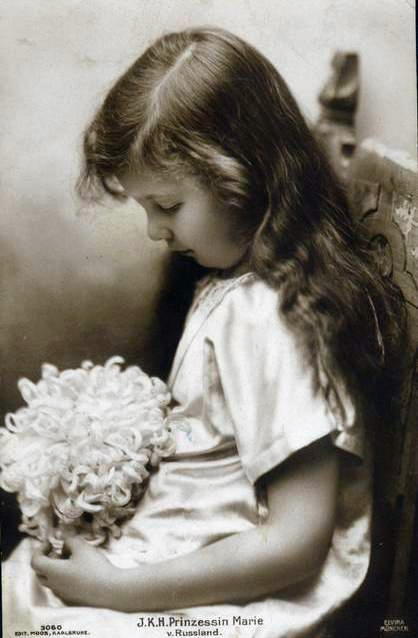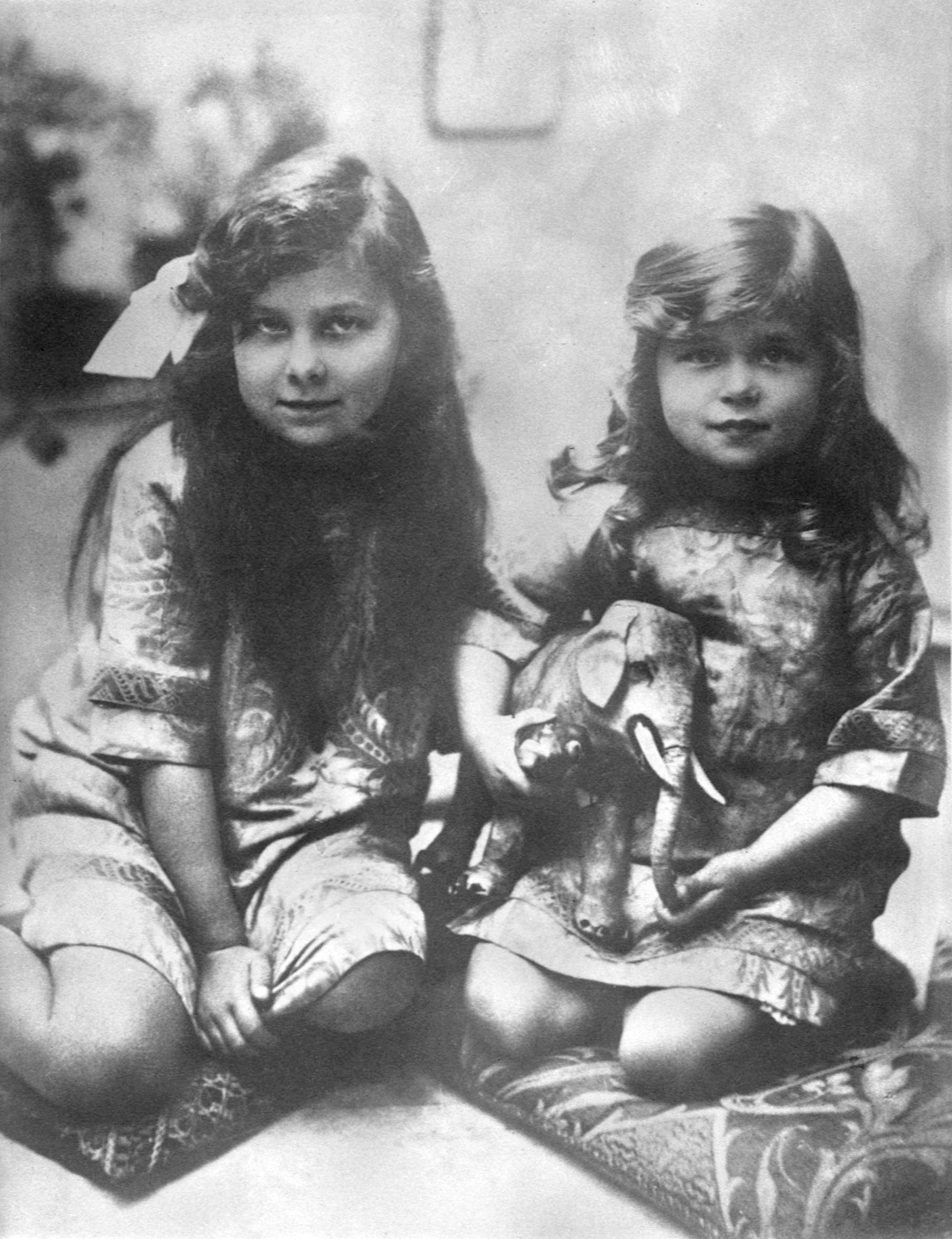1. Overview
Grand Duchess Maria Kirillovna of Russia (Мария КирилловнаMariya KirillovnaRussian) was a prominent figure of the exiled Russian Imperial Family, born on February 2, 1907, and passing away on October 25, 1951. She was the eldest daughter of Grand Duke Kirill Vladimirovich of Russia and Princess Victoria Melita of Edinburgh, her birth occurring in Coburg, Germany, while her parents were in exile due to Tsar Nicholas II's disapproval of their marriage. Often referred to as "Marie" (the French form of her name) or "Masha" (her Russian nickname), Maria's life was profoundly shaped by significant macro-historical events. Her family returned to Russia before World War I, but the Russian Revolution of 1917 forced them to flee once more. Her marriage to Karl, 6th Prince of Leiningen, and the subsequent birth of their seven children were overshadowed by the immense hardships of World War II, which tragically led to her husband's forced conscription into the German army, his capture by Soviet forces, and his death from starvation in a concentration camp in 1946. As a widow, Maria faced severe financial struggles while raising her surviving children, a testament to the devastating impact of war and ideological conflict on individual lives. She died five years later from a heart attack at the age of forty-four.
2. Life
Maria Kirillovna's life unfolded against a backdrop of profound political and social upheaval, marked by periods of exile, war, and personal tragedy.
2.1. Early life and upbringing
Maria was born on February 2, 1907, in Coburg, Germany, during her parents' exile, as their marriage had not received the approval of Tsar Nicholas II. She spent her childhood primarily in Coburg and later in Saint-Briac-sur-Mer, France. Initially, she was styled Princess Maria Kirillovna of Russia as a great-granddaughter of a Russian Emperor, but her father, Grand Duke Kirill Vladimirovich, granted her the title Grand Duchess of Russia with the style Imperial Highness in 1921, when he declared himself Guardian of the Throne. He later claimed the title of Emperor in 1924, at which point Maria formally used the title of Grand Duchess.
The family returned to Russia before the outbreak of World War I, but the tumultuous events of the Russian Revolution of 1917 compelled them to flee the country once more, sending them into exile again.

Physically, Maria resembled her maternal grandmother, Grand Duchess Maria Alexandrovna of Russia, with dark hair, dark eyes, and a wide, round face. She also had a tendency to be overweight and, even in her teenage years, often looked older than her actual age. Described as "shy and easy-going," Maria's personality was introverted and relaxed, in contrast to her younger sister, Kira. Maria nonetheless had her share of notable incidents. In 1922, at the age of fifteen, the "flighty" Maria visited her aunt, Queen Marie of Romania. During this visit, she engaged in a flirtation with the son-in-law of a lady-in-waiting at the Romanian court. Her thirteen-year-old cousin, Princess Ileana of Romania, subsequently spread rumors about this flirtation upon Maria's return home, leading to strained relations between Queen Marie of Romania and Maria's mother, Victoria. Fortunately, the conflict was eventually smoothed over, but the incident highlighted her spirited, if sometimes mischievous, personality.
2.2. Marriage and family
On February 24, 1925, Maria became engaged to Karl, 6th Prince of Leiningen, who was born on February 13, 1898. They married nine months later on November 25, 1925. Her mother, Victoria, was present at Maria's bedside for the birth of her first child, Emich Kirill, in 1926, and continued to attend the subsequent births of Maria's children.
Maria and Karl ultimately had seven children. However, their family life was severely impacted by the onset of World War II. One of their children tragically died in infancy during the war. Her husband, Karl, was forced to join the German army, a grim fate for many men during that period. At the end of World War II, he was taken captive by Soviet forces. He succumbed to starvation in a Russian concentration camp in 1946, a profound loss that left Maria a widow. This event tragically illustrates the devastating human cost of war and ideological conflict, directly impacting individual families and leaving them shattered.
2.3. Later life and death
Following her husband Karl's death in the Soviet concentration camp in 1946, Grand Duchess Maria Kirillovna faced immense financial struggles. Left with very little money, she valiantly struggled to support and raise her six surviving children on her own. The hardship of widowhood combined with the post-war economic difficulties significantly burdened her. Maria passed away five years after her husband, on October 25, 1951, at the age of forty-four. Her cause of death was a heart attack, underscoring the toll that years of hardship and stress had taken on her.
3. Ancestry
Maria Kirillovna's ancestry traces back through several prominent European royal houses, linking her to both the Russian Imperial Family and various German ducal lines, as well as the British monarchy through her maternal grandmother.
| Grand Duchess Maria Kirillovna of Russia's Ancestry | ||||
|---|---|---|---|---|
| Number | Name | Relation | Parent (Number) | Parent (Number) |
| 1 | Maria Kirillovna, Princess of Leiningen | Self | ||
| 2 | Grand Duke Kirill Vladimirovich of Russia | Father | 4 | 5 |
| 3 | Princess Victoria Melita of Edinburgh | Mother | 6 | 7 |
| 4 | Grand Duke Vladimir Alexandrovich of Russia | Paternal Grandfather | 8 | 9 |
| 5 | Duchess Marie of Mecklenburg-Schwerin | Paternal Grandmother | 10 | 11 |
| 6 | Alfred, Duke of Saxe-Coburg and Gotha | Maternal Grandfather | 12 | 13 |
| 7 | Grand Duchess Maria Alexandrovna of Russia | Maternal Grandmother | 14 | 15 |
| 8 | Alexander II of Russia | Paternal Great-Grandfather | ||
| 9 | Princess Marie of Hesse and by Rhine | Paternal Great-Grandmother | ||
| 10 | Frederick Francis II, Grand Duke of Mecklenburg-Schwerin | Paternal Great-Grandfather | ||
| 11 | Princess Augusta Reuss of Köstritz | Paternal Great-Grandmother | ||
| 12 | Prince Albert of Saxe-Coburg and Gotha | Maternal Great-Grandfather | ||
| 13 | Victoria of the United Kingdom | Maternal Great-Grandmother | ||
| 14 | Alexander II of Russia | Maternal Great-Grandfather | ||
| 15 | Princess Marie of Hesse and by Rhine | Maternal Great-Grandmother |
4. Descendants and legacy
Grand Duchess Maria Kirillovna and Karl, 6th Prince of Leiningen, had seven children, ensuring the continuation of their family line through the generations. Despite the hardships faced, particularly after Karl's death, her descendants have gone on to form their own families and maintain connections across European nobility. Her legacy is primarily carried through the lives and families of her children.
Maria and Karl's children were:
- Prince Emich Kirill Ferdinand Hermann of Leiningen (October 18, 1926 - October 30, 1991); he became the head of the House of Leiningen. Emich married Duchess Eilika of Oldenburg on August 10, 1950. They had four children.
- Prince Karl Vladimir Ernst Heinrich of Leiningen (January 2, 1928 - September 28, 1990); he married Princess Marie Louise of Bulgaria on February 20, 1957. They divorced on December 4, 1968, and had two sons.
- Princess Kira Melita Feodora Marie Victoria Alexandra of Leiningen (July 18, 1930 - September 23, 2005); she married Prince Andrew of Yugoslavia on September 18, 1963. They had three children and later divorced in 1972.
- Princess Margarita Ileana Victoria of Leiningen (May 9, 1932 - June 16, 1994); she married Frederick William, Prince of Hohenzollern on January 5, 1951. They had three sons.
- Princess Mechtilde Alexandra of Leiningen (January 2, 1936 - February 12, 2021); she married Karl Anton Bauscher on November 25, 1961. They had three sons.
- Prince Friedrich Wilhelm Berthold of Leiningen (June 18, 1938 - August 29, 1999); he married Karin-Evelyn Gees in 1960 and they divorced in 1962. He remarried Helga Eschenbacher in 1971.
- Prince Peter Victor of Leiningen (December 23, 1942 - January 12, 1943); he tragically died in infancy.
